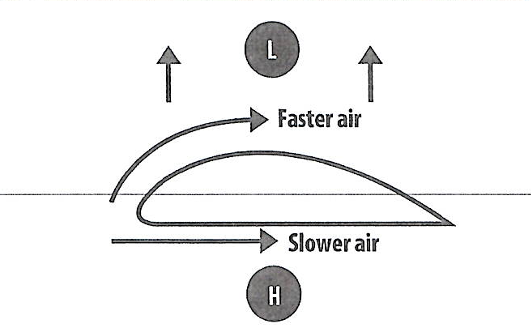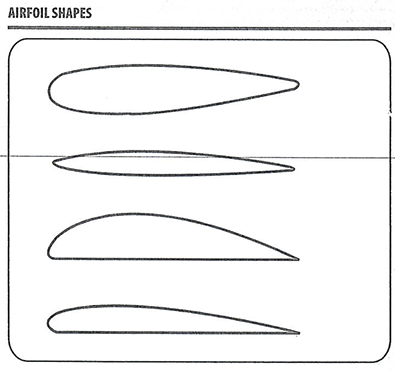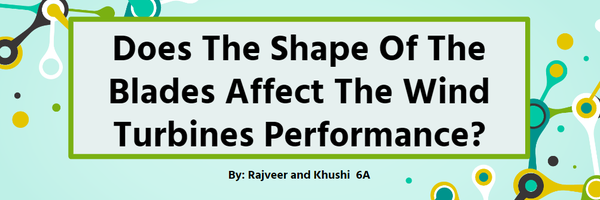Does the shape of the blades affect a wind turbines performance
Grade 6
Presentation
Hypothesis
We believe that the rectangular blades will spin the fastest because of the large surface area. We think the surface area of the rectangular blades will capture more air/wind leading to the weight being lifted faster as the air will act as a strong force lifting it.
Research
Wind power is one of the best and most sustainable forms of renewable energy and we use wind turbines to harvest the energy from the wind to power our homes. Wind turbines are machines that convert the wind's mechanical energy into electrical energy. Wind turbines rely on two main principles. Newton's third law states that “for every action, there is an equal and opposite reaction”. This is true for the wind turbine’s blade. The action is the wind which projects air towards the blade and the reaction is the blade being pushed causing the wind turbine to spin. Bernoulli's principle and Newton's third law. Bernoulli’s principle states that “faster-moving air has lower pressure”. This is true for the wind turbine blade because the blade is an “airfoil shape” (cont…)Wind turbines usually have a curved airfoil-shaped blade. This causes the wind to move faster over the curved side increasing the overall speed of the wind turbine. Wind turbines work on a principle, instead of using electricity like a house fan, wind turbines use the wind moving through it to make electricity. The motor will turn the blades that also spin a strong generator, producing electrical energy. This is called renewable energy, renewable energy is energy that does not run out. The first ever electricity-generating wind turbine was made in 1887 by a Scottish professor James Blyth in Glasgow, Scotland. We researched different types of blades of the wind turbine and that's how our project will work with the help and power of the fan, winds will travel through the turbine resulting in it spinning like you would see in the countryside.
Some Pictures:


Variables
Dependent
- The time the different blade types take to spin around.
Controlled
- The amount of weight
- The speed of the fan
- The distance of the fan from the bottle
Independent
- The shape of the blades
Uncontrolled
Fan’s Power: We had no way of measuring the speed of the wind coming from the fan so the power of the fan might not have been constant which wouldn’t give us accurate results.
Procedure
1. Gather the materials.
2. Cut the top of the 1-liter bottle and create flaps on either side of the bottle. Fill the bottom of the bottle with marbles.
3. With the help of an adult we drilled a hole on each side of the 500-ml bottle and inserted a straw through it.
4. Attach the 500-ml bottle between the flaps of the 1-liter bottle as shown.
5. Then we cut the paper into 3 different shapes. We made rectangle, square,and triangle. We then folded each paper in half and taped the two longer edges forming a teardrop shape and curved them in the opposite direction.
6. We glued each paper on the ends of a straw just enough for a blade to be secured. Glue a blade on either side of the straw as show in the picture 6.
7. Repeat step six with the other blades.
8. Grab some paper clips and straighten them out. Twist the paperclip in the middle to form a “T” shape.
9. Put the “T” shape paperclip in between the blades. Creating something that looks like a handle. Add a straw to the bottom of the paperclip.
10. Take another paperclip and hang it from a string. Then attach the string to the end of the straw and put one flat washer for weight.
11. Put it all together and you have got yourself a wind turbine.
Observations
|
Triangle Blades (Blue) |
Trials | |||
| 1 | 2 | 3 | Average | |
| Time in seconds | 3.45 | 3.63 | 3.68 | 3.59 |
| Squared Blades (Yellow) | Trials | |||
| 1 | 2 | 3 | Average | |
| Time in seconds | 2.64 | 2.26 | 2.34 | 2.41 |
| Rectangle Blades (Green) | Trials | |||
| 1 | 2 | 3 | Average | |
| Time in seconds | 2.28 | 2.41 | 2.36 | 2.35 |
| Blade Shape | Trials (time in seconds) | |||
| 1 | 2 | 3 | Average | |
| Triangle (Blue) | 3.45 | 3.63 | 3.68 | 3.59 |
| Squared (Yellow) | 2.64 | 2.26 | 2.34 | 2.41 |
| Rectangle (Green) | 2.28 | 2.41 | 2.36 | 2.35 |
Analysis
From this graph, you can see that the rectangular blades (green) did the best with an average of 2.35 seconds. In second place was the squared blade (yellow) with an average of 2.41 seconds. The blade with the longest time was the triangular blade (blue) with an average of 3.59 seconds.
We hypothesized that the Rectangular blade (Green) would spin the fastest. After experimenting we found that our hypothesis was correct because the Rectangular blades (Green) took the least time to rotate and took an average of 2.35 seconds.
Conclusion
We hypothesized that the Rectangular blade (Green) would spin the fastest. After doing the experiment we found that our hypothesis was correct because the Rectangular blades (Green) took the least time to rotate and took on average 2.35 seconds.
Application
Wind turbines are found in rural communities and areas so the best example of “who would use this information’’, is farmers, as they usually live in large fields away from the urban cities and towns. Since farmers live in rural communities they would need electricity from somewhere. So one of the most popular ways is wind turbines to generate electricity. Wind turbine's principal is very simple.” instead of using electricity like a house fan, wind turbines use the wind moving through it to make electricity. They generate electricity by using” 2 or 3 blades connecting to the rotor and forming a propeller. The rotor is also connected to the main shaft. The main shaft is a device that transfers the revolution from the rotor into the gearbox with a typical rotation of 20 rpm (revolution per minute). The main shaft creates electricity by spinning a generator.
Sources Of Error
- The blades got stuck on the tap of the 500-ml bottle
- we made sure that the hole in the bottle is smooth and big enough for a straw to spin freely.
- The size of the fan, first we experimented with the smaller fan but it did not work due to less speed to pull the flat washer up.
- We used a bigger fan with adjustable speed for our experiment.
- The straws
- The plastic straws we used before were too light weight and were not working so we switched to paper straws to give strength to our fan.
Citations
References:
- https://www.sciencebuddies.org/science-fair-projects/project-ideas/Aero_p040/aerodynamics-hydrodynamics/wind-turbine-design
- https://science.howstuffworks.com/environmental/green-science/wind-power.htm#pt3
- https://www.msichicago.org/support/donate/annual-fund/curiosity-society/curiosity-brief/can-renewable-energy-power-the-world/
- https://www.iberdrola.com/sustainability/wind-turbines-blades
- https://www.energy.gov/eere/wind/how-do-wind-turbines-work
- https://www.opusenergy.com/blog/13-little-known-facts-about-wind-energy/
- https://www.energy.gov/eere/wind/advantages-and-challenges-wind-energy#:~:text=Wind%20 turbines%20 harness%20energy%20 from,fuel%20 or%20 polluting%20the%20 air.
- chrome-extension://efaidnbmnnnibpcajpcglclefindmkaj/https://www.nmmesa.org/wp-content/uploads/2019/10/Aerodynamics-of-Wind-Turbine-Blades.pdf
Acknowledgement
We sincerely acknowledge and thank everyone who helped us with this project. Our teacher Mrs.Richards monitored our work and gave us creative ideas for our Science fair project. We would also like to thank Mrs.Aulakh for helping us throughout this project and giving us tips on how to improve in the future. We would also like to thank Khalsa School Calgary for giving us this great opportunity to participate in CYSF and setting us up for success. We want to thank our parents for their continuous encouragement and give their support to help us improve our project. We would also like to thank our sister for helping us with the statistics part of the project. Lastly, we would like to thank our judges and viewers for listening to our project.

